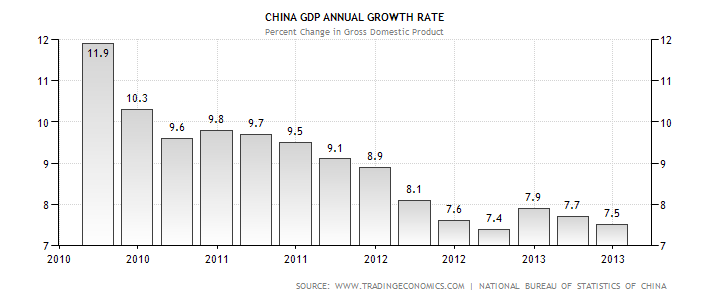China’s trade and economic data for June and the June quarter were weak, as expected, but markets took the news in their stride, unlike the silly reactions to weak Chinese data on numerous of occasions in the past few months.
The Australian dollar didn’t fall out of bed – it rose three quarters of a cent in local trading, and the stockmarket closed with small gains. It was a grown up, mature reaction.
The dollar ended around 91.10 USc at the close of local trading yesterday. the ASX ended up around 7 points, while the Chinese market also ended with gains.
Second quarter economic growth slowed to 7.5% in the second quarter compared to a year earlier, down from 7.7% in the first quarter and in line with the latest official target for this year.
China’s growth has now fallen in nine of the past ten quarters, so the transition to a lower rate of economic growth is clearly here.
3Y China GDP Growth – Slowing but stable

Quarter on quarter growth rose to 1.7% from 1.6% in the first quarter (which is an annual rate of 6.6%), pointing to the way growth continues to slow and meaning there’s now a very real chance growth could be up under 7.5% for the year.
That would be the first miss of the annual growth target in 15 years. Growth for the first two quarters was an annual 7.6% (which is still considerably faster than any of the world’s other major economies).
Industrial production slowed to 8.9% annual in June from 9.2% in May.
But steel production from the country’s many blast furnace operators rose 4.6% to 64.44 million tonnes in June, from a year ago.
That was down more than three million tonnes, or nearly 4%, from the 67 million tonnes produced in May, which helps explain the slight fall in iron ore imports last month.
But even then imports of iron ore from Australia were still at very high levels last month, as they have been for much of this year, which helps explain why world spot iron ore prices remain solid at around $US125 a tonne.
The June rate of growth for industrial production is equal to what it was in the mid-year slowdown last year, but it is also sharply lower than the 10% growth rate at the end of last year and into early 2013.
That confirms the slowdown in activity that those two monthly surveys of manufacturing have been showing off and on for most of the past year.
But analysts say there doesn’t seem to be all that greater concern in the government – hence the kerfuffle we reported yesterday over those comments from the country’s finance minister about 2013 growth estimates that the Chinese official media have tried to cover up.
“I think the second half will be even weaker. The government’s tolerance for slower growth is definitely higher. 7 per cent is probably the growth floor,” said Zhu Haibin, an economist with JPMorgan. “Big stimulus is not going to come out, that is for sure. But there is some room for small-scale stimulus, like support for specific industries,” the Financial Times reported.
That sort of remark was commonplace in yesterday’s myriad reports, so markets are accepting now that China’s economy is slowing forever and slowing for the right reasons as the government continues to drive to boost private consumption, tackle graft, corruption and bribery (which is hurting luxury retail sales and sales of some cars), as well as trying to start the long process of improving the environment.
That though is going to run headlong into opposition from various provincial governments and national departments, and big state-owned Enterprises such as oil, mining, copper, aluminium, steel and chemical companies who depend on high investment spending for their revenues and meagre profits (and the enrichment of their executives and government backers).
This is something to keep in mind when next you read or hear markett analysts and others expressing fears about "slowing Chinese growth". Yesterday we had the evidence and the reaction was pretty accommodating in western markets.
Retail sales edged up to an annual rate of 13.3% in June from 12.8% in May. They are up on the lower growth rates earlier this year, but still behind the 14% to 17% growth rates seen in 2011 and 2012.
Even at 7.7%, growth remains solid as the performance of the country’s power industry in June confirms.
Data out yesterday showed China’s electricity consumption rose 6.3% in June from a year earlier to 438.4 billion kilowatt hours. Power consumption in the first half of the year totalled 2.5 trillion kilowatt hours, up 5.1% on the first half of 2012.year.
China’s State Electricity Regulatory Commission estimated at the start of the year that China’s power demand may increase 9% this year, faster than the 5.5% increase in 2012.
So power consumption is running ahead of 2012, when growth was slightly faster.
Data out last week showed slowing exports and imports and a jump in consumer inflation in June.













